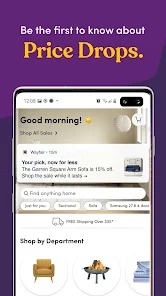WHAT IS WAYFAIR?
The Boston, Massachusetts-based American e-commerce business Wayfair was established in 2002 and specializes in the online sales of furniture and home items. Wayfair manages five retail websites under its own brands: Birch Lane, AllModern, Joss & Main, and Perigold, in addition to the popular Wayfair site.
To provide a one-stop shop for furniture, home furnishings, décor, and products as well as to boost brand awareness, customer loyalty, and repeat business, Wayfair made the decision to deactivate and permanently redirect over 240 of its specialist websites into Wayfair.com in late 2011.



HOW DOES WAYFAIR WORK?
The Wayfair business strategy relies on an online storefront that provides clients with browsing that is aesthetically stimulating, captivating merchandising, simple product discovery, and appealing pricing for more than 33 million items from more than 23,000 suppliers (as of the 2021 Annual Report).
Wayfair is aware that consumers buy for their homes with a variety of interests, styles, aspirations, and budgets. As a result, Wayfair’s business strategy provides a substantial online assortment of furniture, accessories, housewares, and home renovation goods. Wayfair only keeps a small amount of inventory, which allows it to offer such a large selection of products.
Let’s examine Wayfair’s logistics system as well. The foundation of Wayfair’s business strategy is seamless logistics. The logistics network at Wayfair was created especially for the home sector, where products can be big, heavy, and vulnerable to damage.
Historically, a drop-ship network served as Wayfair’s main fulfillment strategy. In the case of dropshipping, a retailer doesn’t hold inventory of the goods it sells. Wayfair’s suppliers were able to view and deliver the orders to the customers’ homes because to the integration of technology between them.
Depending on the size of the shipment, the delivery would either be done by third-party line haul trucking firms and third-party last-mile home delivery agents, or by carriers like FedEx, UPS, DHL, or the U.S. Postal Service.
By providing clients with quicker delivery times and a better experience receiving packages at their homes, Wayfair hopes its unique logistics network will help generate additional sales. By lowering damage rates and taking advantage of transportation economies of scale, Wayfair anticipates that this network will eventually result in reduced costs per order as well.
Now that we have a good knowledge of how Wayfair operates, let’s examine how it generates revenue and the various components of its business model.


REVIEWS AND COMMENTS OF WAYFAIR APP
“Finding what you’re seeking for does not require scrolling through many things! The word “filters” is displayed in the very top right corner of every search result page. You may easily filter your search by clicking on it to your heart’s content. The software occasionally freezes and glitches, which is the only problem I have with it. Additionally, since there is no Buy It Now option, your odds of finding an open box or sale item are essentially nonexistent if you have 30 or more things in your basket.” – Shayla Duke
“Purchasing is made incredibly simple by ordering, sale rates, and FREE SHIPPING! We have been pleased with every purchase we have made because they have all been of excellent quality. Before finalizing a transaction, we frequently read client evaluations, thus this new option is quite beneficial. Shipping is always on time—it has never been early, although occasionally early and FREE is a great deal! Items are properly wrapped, and there haven’t been any issues with damage. There are several reasons why we adore Wayfair!!” – K Smith













